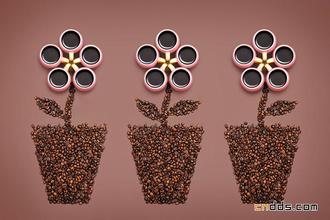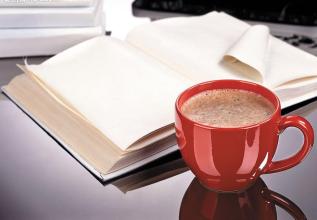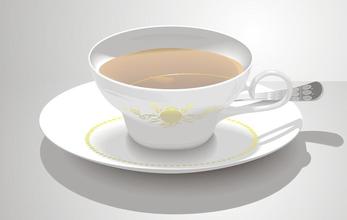1 minute to improve your coffee taste
1. Shallow baking (Light Roast) vs deep baking (Dark Roast)
According to the American classification, the roasting of coffee beans can be divided into eight stages from shallow to deep. The taste of coffee mainly depends on the baking degree. Generally, the deeper the roasting degree, the stronger the bitter taste, and the lower the roasting degree, the higher the sour taste. Baking depth mainly depends on the characteristics of raw beans, personal preferences and other factors.
two。 Espresso (Espresso) vs dripping Coffee (Drip)
Espresso is made by letting hot water flow through a handful of fine coffee powder under high pressure, with high caffeine concentration and coffee fat. The dripping coffee is to let the boiling water through the coarse ground coffee powder, the caffeine concentration is low, basically does not contain coffee fat, is more suitable for drinking in large quantities.
3. Latte (Caffee Latte) vs cappuccino (Cappuccino)
Lattes and cappuccinos both belong to milk coffee. The main difference lies in the ratio of espresso, milk and milk bubbles. For cappuccino, the amount of espresso, hot milk and foam should be the same (1:1:1), while hot latte milk is more (1:2:1). The latte tastes more compact and delicate, while cappuccino is slightly dry.
4. Latte (Caffee Latte) vs Ole coffee (Cafe au Lait)
Simply put, lattes are made from Espresso and steamed milk, while Ole coffee is made from dripping coffee with steamed milk.
5. Arabica (Arabica) vs Robusta (Robusta)
In terms of varieties, coffee trees are mainly divided into two types: one is Arabica, the other is Robusta.
Arabica coffee is mainly produced in tropical South America, such as Central Brazil, with smaller bean shape, lower caffeine content and higher price.
Robusta is produced in Madagascar in west-central and eastern Africa, and Indonesia in Asia. It has a large bean shape, about twice the caffeine content of Arabica, and a low price. About 75 per cent of the world's coffee is Arabica, but only 10 per cent is coffee that can be used in upscale coffee shops.
6. The coffee spoon is not for scooping coffee.
Add sugar and stir coffee is the "full-time" coffee spoon, use it to scoop a sip of coffee is a rude thing, and do not use it to "help" smash the cube sugar in the cup. When drinking, take it out of the cup and put it on the plate.
7. Blowing cold coffee with your mouth is not elegant enough.
Freshly brewed coffee is so hot that you can gently stir it in the cup with a coffee spoon to cool it, or wait for it to cool naturally before drinking it. It is very impolite to try to cool the coffee with your mouth.
8. Pay attention to drinking temperature
Coffee should be drunk while it is hot, 91 to 96 degrees can give off the original flavor, and 85 to 88 degrees is the best to drink.
9. How to add sugar to coffee
When adding sugar to the coffee, the sugar can be scooped with a coffee spoon and added directly to the cup, or you can first use a sugar clip to clip the cube sugar on the near side of the coffee plate, and then use the coffee spoon to add the cube sugar to the cup.
10. Try black coffee.
Be sure to try black coffee. Every coffee bean takes five years to grow before it can blossom, bear fruit, pick, and then be processed and ground into a drink in your hands. Therefore, only black coffee without sugar or milk is most faithful to the original taste of coffee and can make you feel the essence of this plant.

Important Notice :
前街咖啡 FrontStreet Coffee has moved to new addredd:
FrontStreet Coffee Address: 315,Donghua East Road,GuangZhou
Tel:020 38364473
- Prev

All the knowledge of drip coffee
The rise of the boutique coffee market has undoubtedly led the public's attention to shift to a more diversified way of brewing coffee. Among them, the most important thing that can not be ignored is trickling coffee, which appeared at the beginning of coffee culture. Speaking of which, babies must have a lot of questions. What is dripping coffee? Are all hand-brewed coffee filtered? Does Philharmonic pressure belong to drip coffee? Don't touch it.
- Next

How many ways are there to make coffee?
Drip filter coffee was originally invented by the Germans. Supermarkets sell Melita coffee pot filter paper, which is the brand founded by the Germans at that time. The practice of dripping filter coffee, in short, is to grind the coffee into powder, put it in a funnel with a layer of filter paper, and then pour hot water on it. Due to the gravity of the earth, the coffee will flow out at the bottom (so if it is in space, there is no earth.
Related
- Beginners will see the "Coffee pull flower" guide!
- What is the difference between ice blog purified milk and ordinary milk coffee?
- Why is the Philippines the largest producer of crops in Liberia?
- For coffee extraction, should the fine powder be retained?
- How does extracted espresso fill pressed powder? How much strength does it take to press the powder?
- How to make jasmine cold extract coffee? Is the jasmine + latte good?
- Will this little toy really make the coffee taste better? How does Lily Drip affect coffee extraction?
- Will the action of slapping the filter cup also affect coffee extraction?
- What's the difference between powder-to-water ratio and powder-to-liquid ratio?
- What is the Ethiopian local species? What does it have to do with Heirloom native species?

